On Guards
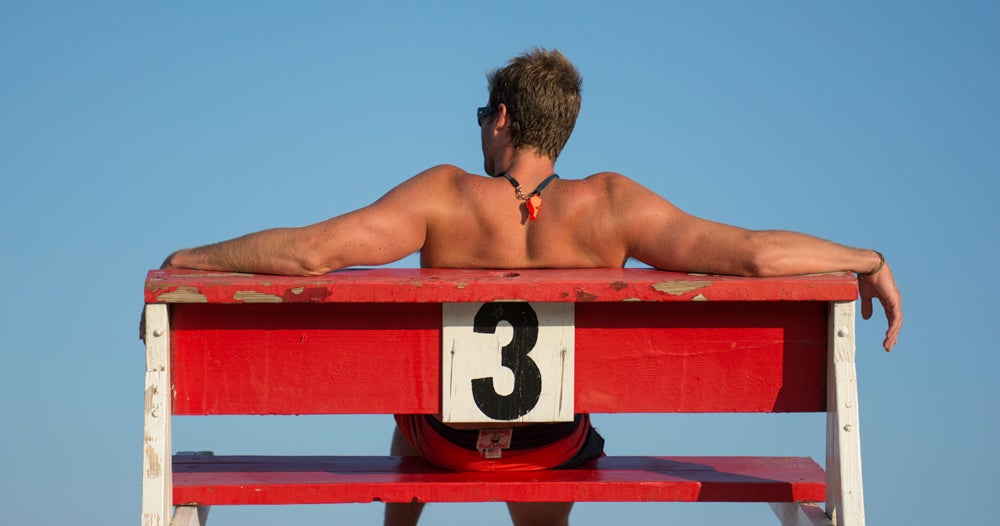
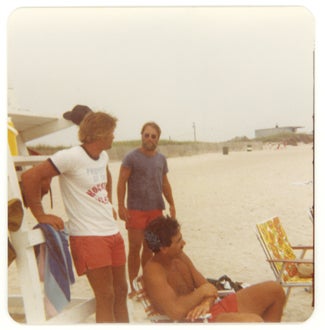
Riptides, close calls, what it’s like to be the one with a whistle when summer fun turns dangerous—stories from the URI lifeguards who watch over us all.
By Dave Lavallee ‘79, M.P.A. ‘87
Late summer is always a challenge.
College calls lifeguards back to their dryland lives, until by the end of August, managers at Rhode Island’s 36 guarded fresh and salt-water beaches are juggling schedules to keep the chairs full.
Jenna Pari ’18, a five-year veteran of South County beaches, remembers a late-summer day two years ago when a hurricane offshore was pushing big waves at Misquamicut. By then, many of the guards left at the popular beach near Westerly, R.I., were fellow URI students. “A bunch of people got stuck in a big rip,” Pari, a fourth-year pharmacy student from Exeter, R.I., recalls. “All six of us were in the water instantly.”
Beachgoers pitched in, manning two tow lines. “I pulled out two people, including a 6-year-old boy,” Pari says. “People were on the shore clapping. The best feeling is when a mom is waiting on the shore, afraid, and then you get to hand her child to her.”
And that is how most rescue stories end: well. The Department of Environmental Management, the state’s biggest lifeguard employer—it hired 142 to protect 15 state-run beaches last year—doesn’t keep figures, but spokeswoman Gail Mastrati says drownings “are extremely rare.” Lifeguards, she adds, wear many hats: “They are trained not only for aquatic-related emergencies, but also for emergency medical situations on shore. They are a beach’s first responders.”
Sand Dollars
Tourism research indicates beaches are the single biggest inspiration for vacationers who visit Rhode Island, and the three million people who dally along Ocean State shores each summer constitute a major economic engine. South County’s 20 beaches “are jewels in the crown,” says the region’s tourism director, Myrna George.
Lifeguards make from minimum wage to $13 an hour; those with an instructor certificate, required for beach captains, make a little more. No one’s getting rich, but from Harry Eisenberg ’66 to Andrew Lavallee ’17, it’s helped defray tuition costs for decades of students.
For the University, in fact, lifeguarding is something of a cottage industry. Last year, almost 50 trainees took lifesaving classes at Tootell Aquatic Center, a mix of URI and local high school students, while another 27 working guards re-upped their two-year certification. Classes start in the fall and run through the spring, with the first DEM certification test in late May. Some 90 percent of applicants pass the first time.
They’ll go on to a job that’s a Rhode Island rite of passage, and that still—whether or not you remember Baywatch—holds an undeniable glamour.
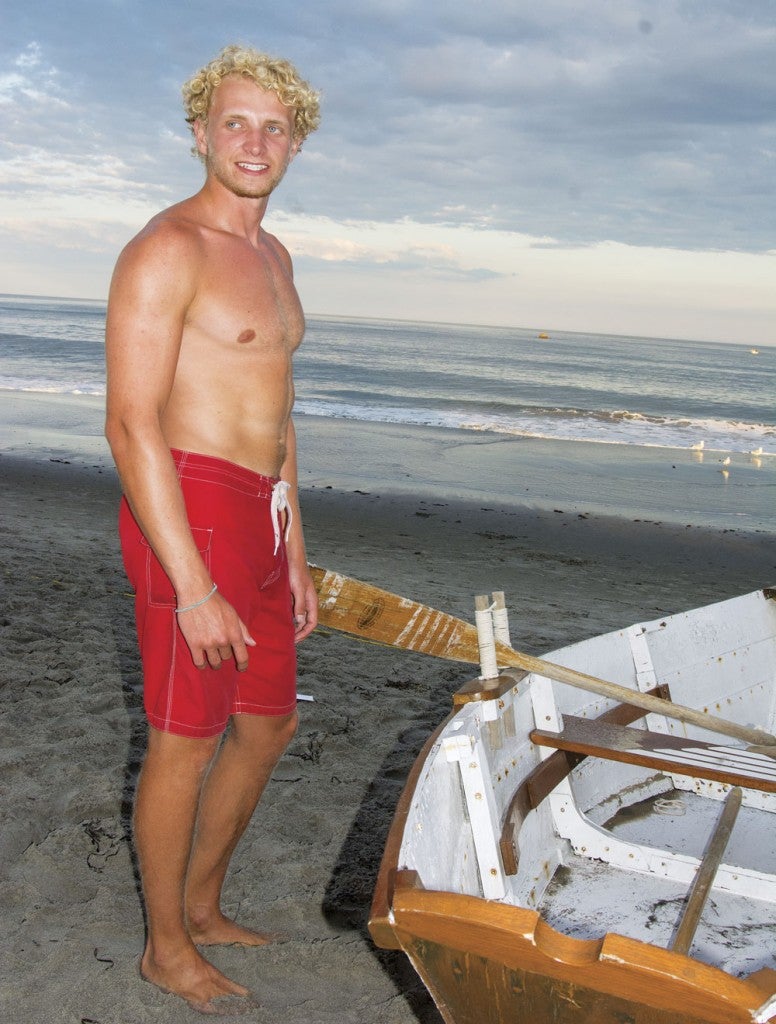
Care Taker
Left, Alexander Mason ’18, a nursing major, worked at East Matunuck last year. “I will be doing clinical rotations in hospitals coming up,” he says, “and my lifeguard experience will come in handy.” He has his sights set on a master’s as a nurse practitioner or nurse-anesthetist. “When my grandmother in England was ill, it was amazing to see how the hospice workers and nurses helped her. That’s what I want to do.”
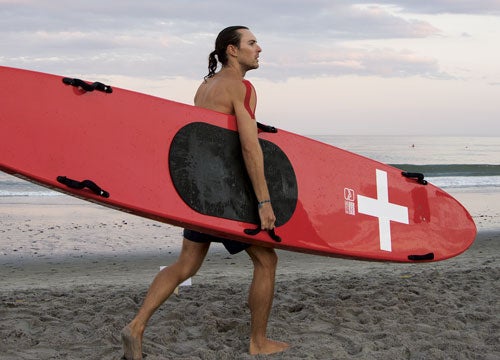
Fit for Rescue
Above, Matthew Cunningham ’10, a former track and field champ at URI and lifeguard at Easton’s Beach in Newport. “We have a very tight-knit group,” he says, “with a one-hour mandatory workout session each day—we swim, run, kayak, paddleboard or row.”
Surf Test
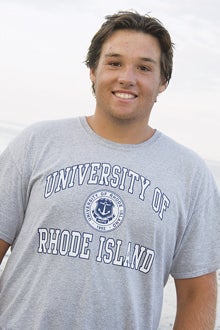
His Race Philosophy
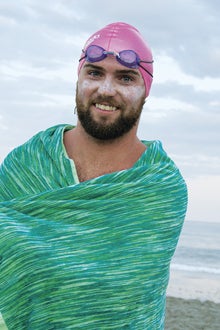
Guard Life
Colleen Cray ’18 was a one-season guard when her car collided with a bus in 2012. “The Scarborough lifeguards started showing up as soon as I was out of the ICU,” says Cray, now studying secondary education and math. “They brought me my favorite foods: doughnuts and Mountain Dew.”
As she tackled months of therapy for a shattered femur and ankle, she got a note from her captains: “They told me there are beach wheelchairs, and you can be the first aid guard. I was sick, but they held me closer—that’s what Scarborough taught me.”
It’s a feeling that the decades do not dim. “It’s like we were a fraternity,” remembers Mike DeLuca ’80, M.C.D. ’88. “Even at my age, when I meet former lifeguards, there’s that moment of recognition—of respect.”
As a 19-year-old, DeLuca’s intentions were murky, if understandable: “I took that first winter swim class to look at girls,” he laughs. “But I soon figured out I did better intellectually if I could burn off some stress. Then after I took the water safety instructor class, I realized this could turn into a job.”
A full immersion into Ocean State guard culture followed: DeLuca taught lifesaving for 10 years, ran the highly competitive state Lifeguard Tournament for another 10, and lifeguarded at Moonstone Beach from 1979–84 (yep, the nude years).
His crew lost a vacationer who followed his girlfriend into a riptide, far beyond the guarded section. A boater retrieved the unconscious man and drove him precious minutes to a Coast Guard Station; he later died. Thirty years later, there’s still an edge to DeLuca’s voice when he recalls how the crew searched for the man, hoping to do CPR. Hard reckonings can come at any moment. “You need a certain mental attitude,” DeLuca says, “a maturity.” Of his guarding cadre, “many have become very successful people: judges, state reps, attorneys, doctors, teachers, triathletes, business owners. They are motivated, and they’re motivated to do good things.”
Now, as community development director for Narragansett, DeLuca says he’s proud his town can boast “the best lifeguards in the state”—a reference to Gansett Surf Rescue’s two-decade reign at the guard games.
But only a fraction of the state’s hundreds of licensed guards compete each August, while on any given day at a beach filled with 10,000 visitors, everyone wearing a red whistle needs a rare combination of skills to make it through an eight-hour shift.
Competitive swimmers naturally gravitate toward lifesaving—all applicants must measure up on a timed swim and other physical feats—but athleticism is only a piece. Guards need patience, focus, decisiveness; they learn to think as a team, and communicate clearly under pressure.
“I can’t just be this carefree kid,” says Nick Neilsen ’19, a guard at East Matunuck State Beach for three years. “If someone is caught in a riptide and they are in trouble, you have to go for it. You can’t wait for someone else to decide.”
No Day at the Beach
At the largest state-run facility, Scarborough, lifeguards watch over 3,000 linear feet of beach frontage. “The most satisfying,” says Jameson Logiodice ’08, one of three captains there last year, “are the rescues and medical emergencies that we respond to where if we hadn’t been there, the patron would have been in serious trouble.”
Logiodice, a physical education teacher with the North Kingstown School Department, was a lifeguard for five years before serving as captain for seven. Last year, his two co-captains, and half of the beach’s 28 regular guards, were also URI students and alumni. “I enjoy every aspect of the job,” he says, “I guess that’s why I stay.”
People can be grateful when a lifeguard helps them, but not always. Some are embarrassed—several guards describe how after the drama and exertion of a rescue, people simply hurry away. Another thing they learn: Don’t count heads. Instead, “we teach lifeguards to scan the entire volume of the water: bottom, middle and surface,” says URI lifesaving instructor Stephanie Stewart. Flags, warning whistles and other preventative tools are key. “Our main concern is preventing risky behaviors in the first place,” Stewart says. If disaster strikes, guards are taught to keep calm and work as a team: “They need to know the fundamentals on how to care for a large number of scenarios, ranging from first aid to a lost child or problem at a facility.”
Equipment has improved over the years, and some beaches have jet skis and robot buoys in their arsenals. But the torpedo buoy remains an anchor of ocean rescue techniques. Easy to carry, torps are also a first line of defense, a tool to both help and fend off a panicking person—so both victim and lifeguard can return safely to shore.
To serve others, to protect yourself—most teens and 20-somethings never take stock of their mortality this way. “You become cautious, notice little things,” says Matthew Cunningham ’10, a lifeguard at Naval Station Newport and a summer guard captain at Easton’s Beach in Newport. “I even drive slower now. I know anything could happen in a matter of seconds.” •
–with reporting by Pippa Jack
Shore Queen
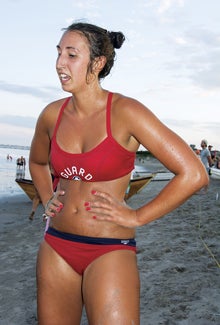

Inside Rips
Rip currents account for 80 percent of rescues by surf beach lifeguards across the country, according to the U.S. Lifesaving Association.
Sometimes sandbars create rip channels; or two trains of waves from different directions meet. In either case, rips “are fed by the energy in breaking waves,” says ocean engineering professor Stephan Grilli.
There’s scary math involved: “Their speed is proportional to the square of the breaking wave height,” says Grilli. “Hence, doubling the breaking wave height will potentially quadruple the rip current speed.”
Although often confused with undertows, another surf phenomenon, rips won’t pull swimmers down. “A swimmer on the surface can be caught in it,” Grilli says, “but because these are always narrow jets, swimming parallel to shore will usually be enough to escape.”
Father to Son
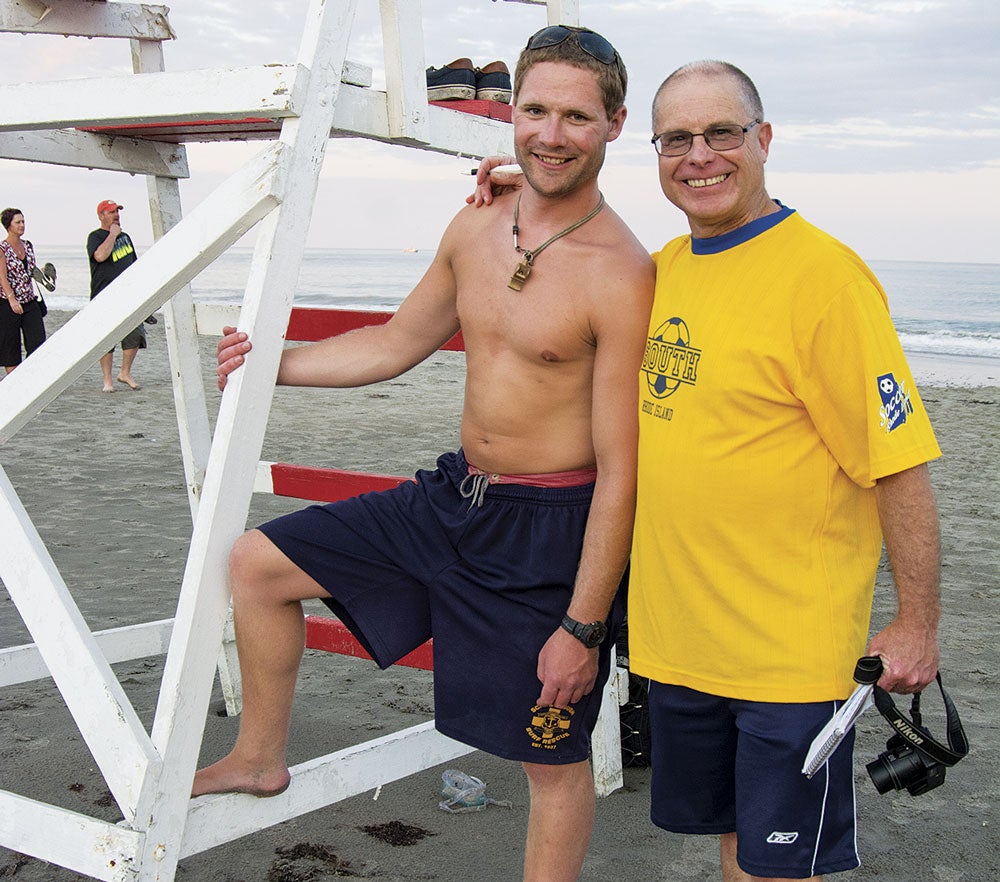
Lifeguard Andrew Lavallee and his dad, former lifeguard Dave at Scarborough Beach, Narragansett, R.I.
Not Waving, and Drowning
Drowning isn’t always a splashy event. URI lifesaving instructor Stephanie Stewart trains students to look for three categories of victims:
• distressed swimmers are having trouble, perhaps from fatigue, and may still be able to wave or call out
• active drowning victims are taking on water while trying to stay at the surface; typically upright in the water, with arms outstretched and trying to push down on the water, they may be a minute or less from sinking
• passive drowning victims are inactive, at the surface or below it
Hopes and fears and a family tradition
By Dave Lavallee ’79, M.P.A. ’87
When I was a Cumberland High School student, my father, Roger Lavallee ’48, came to me with an idea for a summer job: lifeguard. “That’s a great idea, Dad,” I said, “but I can barely swim.”
My dad believed my six siblings and I could do anything if we tried hard enough, so a few weeks later I found myself at Tootell, trying to swim 450 yards in under 10 minutes. I was ordered out of the water—one of the most embarrassing moments of my life. But I returned a couple of weeks later, and passed by seconds.
Then came the outdoor rescue tests. I did fine with the torp, but since I had never rowed a boat, I kept going in circles. When I returned to shore after finally reaching my victim, the guy giving the test asked if I was assigned to a beach, and I said yes, Pulaski State Park in Chepachet, R.I. “Then I’ll pass you,” he said, “but you get your tail in the boat and learn how to row.”
I still remember the rich pine aroma when I drove into the park that first day, and the excruciating sunburn I left with. We never had a drowning during my years there, but we made some saves, found some lost kids, put out a fire at our concession stand with a bucket brigade, performed first aid on countless kids and helped a woman in cardiac distress.
A patron once asked me to find his dentures in the dark, spring-fed water. When I found them, he said, “Thanks young man; you saved me 400 bucks.” I can’t remember if he put them right back in his mouth.
Another time, a bunch of kids came running to my chair, yelling about poop. Now a master of the rowboat, I went out to the offending deposit, scooped it up and disposed of it properly. I guess that was my Caddyshack moment.
One day I was called to Lincoln Woods State Park on a blisteringly hot preseason weekday. I grabbed my trunks, headed over, and got a hot dog. I had finished half the dog when the call came for a swimmer down, around the corner from the marked swimming area. Two guards rowed over; another guard and I ran through the woods in our bare feet. Once we got there, we swam to the spot, and then started diving in what seemed like 15 feet of water. We were all of us gasping by the time we found the unconscious teen, fully clothed, on the bottom. We lifted him into the boat and I began mouth-to-mouth—I remember we couldn’t flatten him out to do CPR. Once we got him to shore, medics took over, and we heard that he had been revived at the hospital. We held out hope, but he later died.
It was the scariest thing I’ve ever been through, and I remember every moment.
My son, Andrew ’17, is entering his sixth year as a guard at Scarborough and is a poised, confident and serious guard. I am proud that his mates and patrons like and respect him. But back when he was a tentative rookie, I made the mistake of offering guidance. He replied: “Dad, thanks for the advice. But you were just a pond lifeguard. This is saltwater, where we have dangerous surf.” •
All Together Now
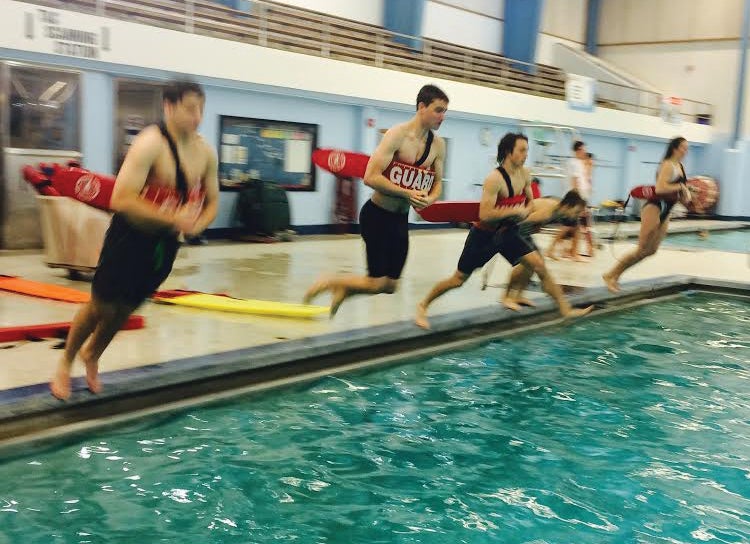
 Home
Home Browse
Browse Close
Close Events
Events Maps
Maps Email
Email Brightspace
Brightspace eCampus
eCampus


